Nurses' Responsibilities and Practice Standards
VerifiedAdded on 2020/04/21
|8
|2530
|51
AI Summary
This assignment delves into the crucial role of nurses in upholding professional practice standards as outlined by the Nursing and Midwifery Board of Australia (NMBA). It emphasizes the importance of adhering to NMBA registration standards, including continuing professional development, recency of practice, English language proficiency, and ethical conduct. The discussion highlights specific examples like NG tube insertion procedures, showcasing how nurses must prioritize patient safety and well-being while navigating complex clinical scenarios.
Contribute Materials
Your contribution can guide someone’s learning journey. Share your
documents today.
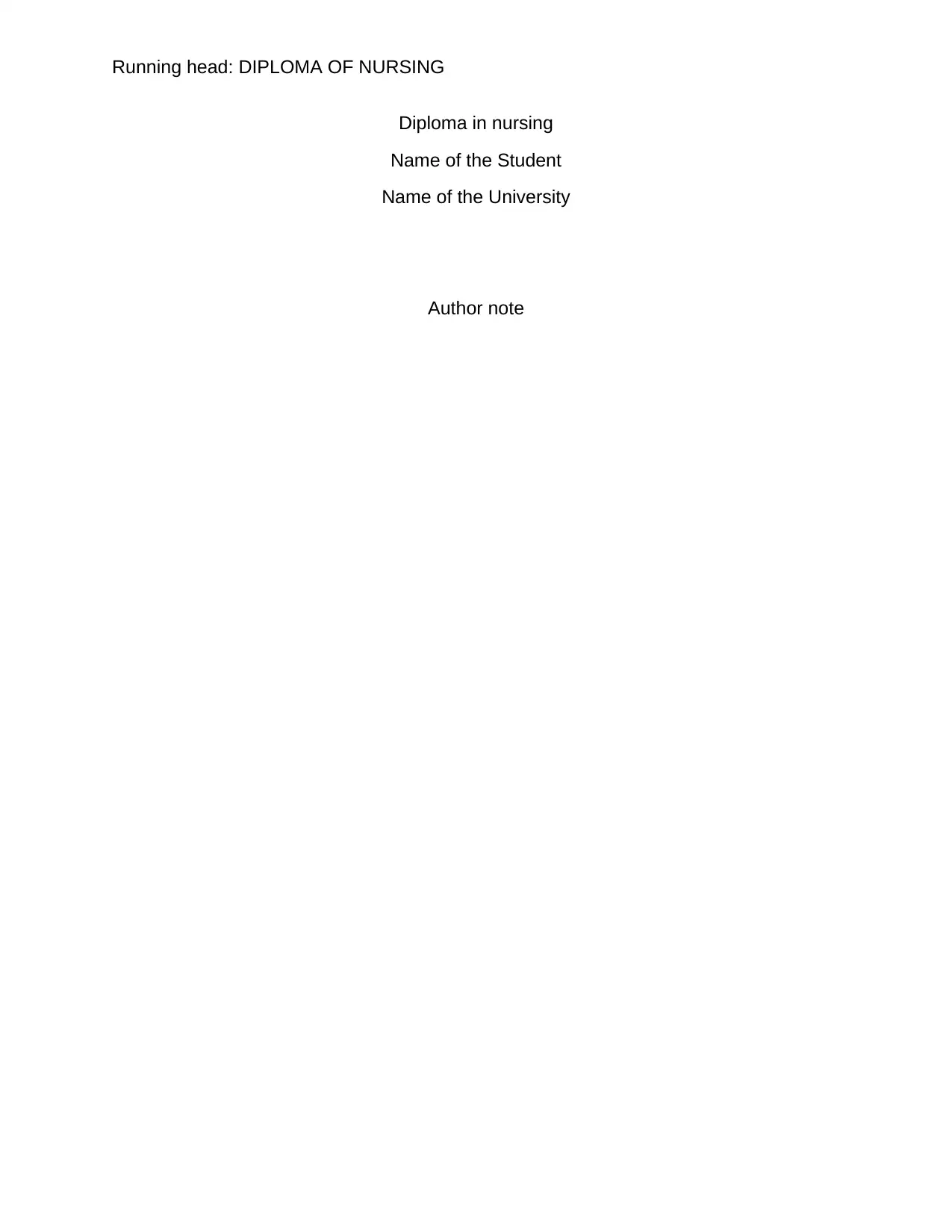
Running head: DIPLOMA OF NURSING
Diploma in nursing
Name of the Student
Name of the University
Author note
Diploma in nursing
Name of the Student
Name of the University
Author note
Secure Best Marks with AI Grader
Need help grading? Try our AI Grader for instant feedback on your assignments.
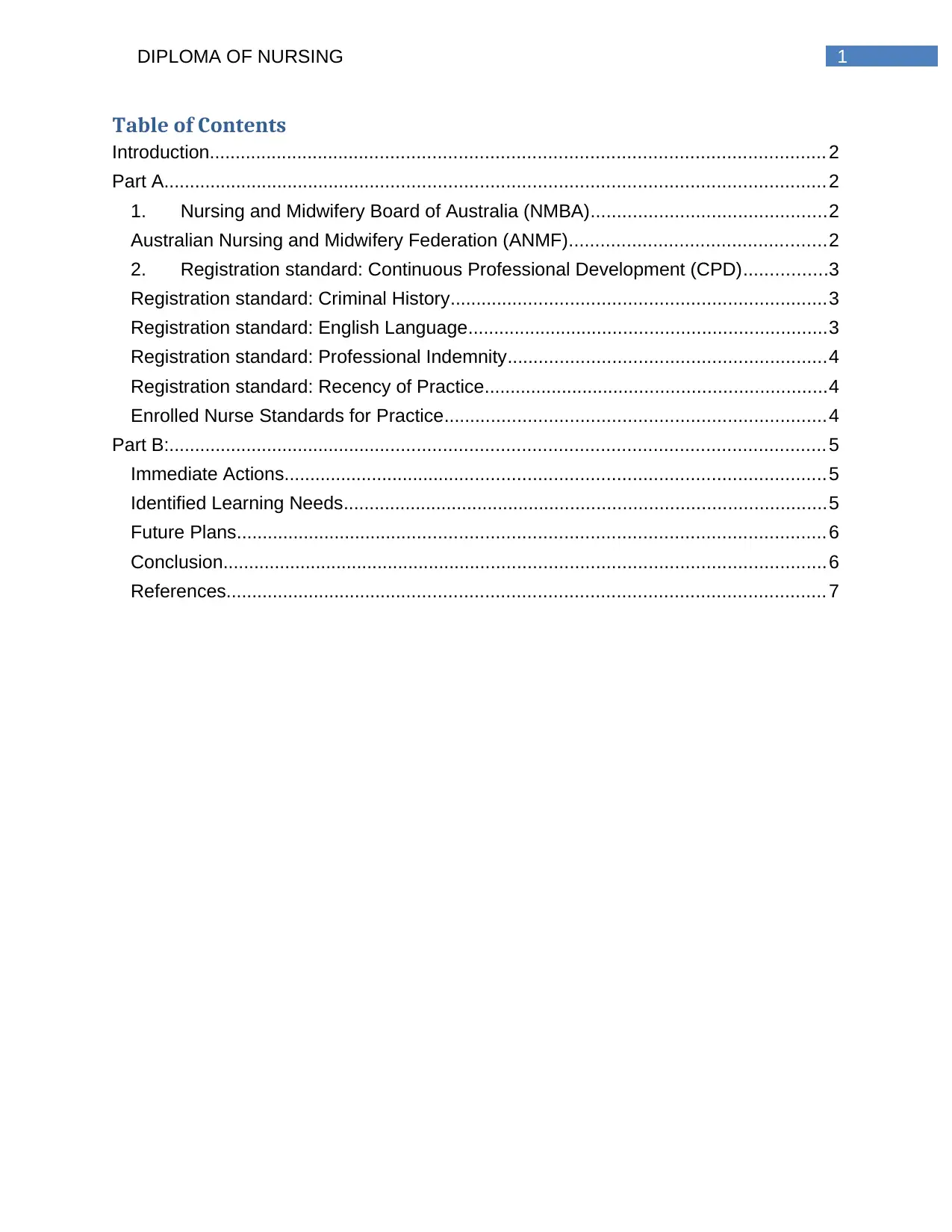
1DIPLOMA OF NURSING
Table of Contents
Introduction...................................................................................................................... 2
Part A............................................................................................................................... 2
1. Nursing and Midwifery Board of Australia (NMBA).............................................2
Australian Nursing and Midwifery Federation (ANMF).................................................2
2. Registration standard: Continuous Professional Development (CPD)................3
Registration standard: Criminal History........................................................................3
Registration standard: English Language.....................................................................3
Registration standard: Professional Indemnity.............................................................4
Registration standard: Recency of Practice..................................................................4
Enrolled Nurse Standards for Practice.........................................................................4
Part B:.............................................................................................................................. 5
Immediate Actions........................................................................................................5
Identified Learning Needs.............................................................................................5
Future Plans................................................................................................................. 6
Conclusion....................................................................................................................6
References................................................................................................................... 7
Table of Contents
Introduction...................................................................................................................... 2
Part A............................................................................................................................... 2
1. Nursing and Midwifery Board of Australia (NMBA).............................................2
Australian Nursing and Midwifery Federation (ANMF).................................................2
2. Registration standard: Continuous Professional Development (CPD)................3
Registration standard: Criminal History........................................................................3
Registration standard: English Language.....................................................................3
Registration standard: Professional Indemnity.............................................................4
Registration standard: Recency of Practice..................................................................4
Enrolled Nurse Standards for Practice.........................................................................4
Part B:.............................................................................................................................. 5
Immediate Actions........................................................................................................5
Identified Learning Needs.............................................................................................5
Future Plans................................................................................................................. 6
Conclusion....................................................................................................................6
References................................................................................................................... 7
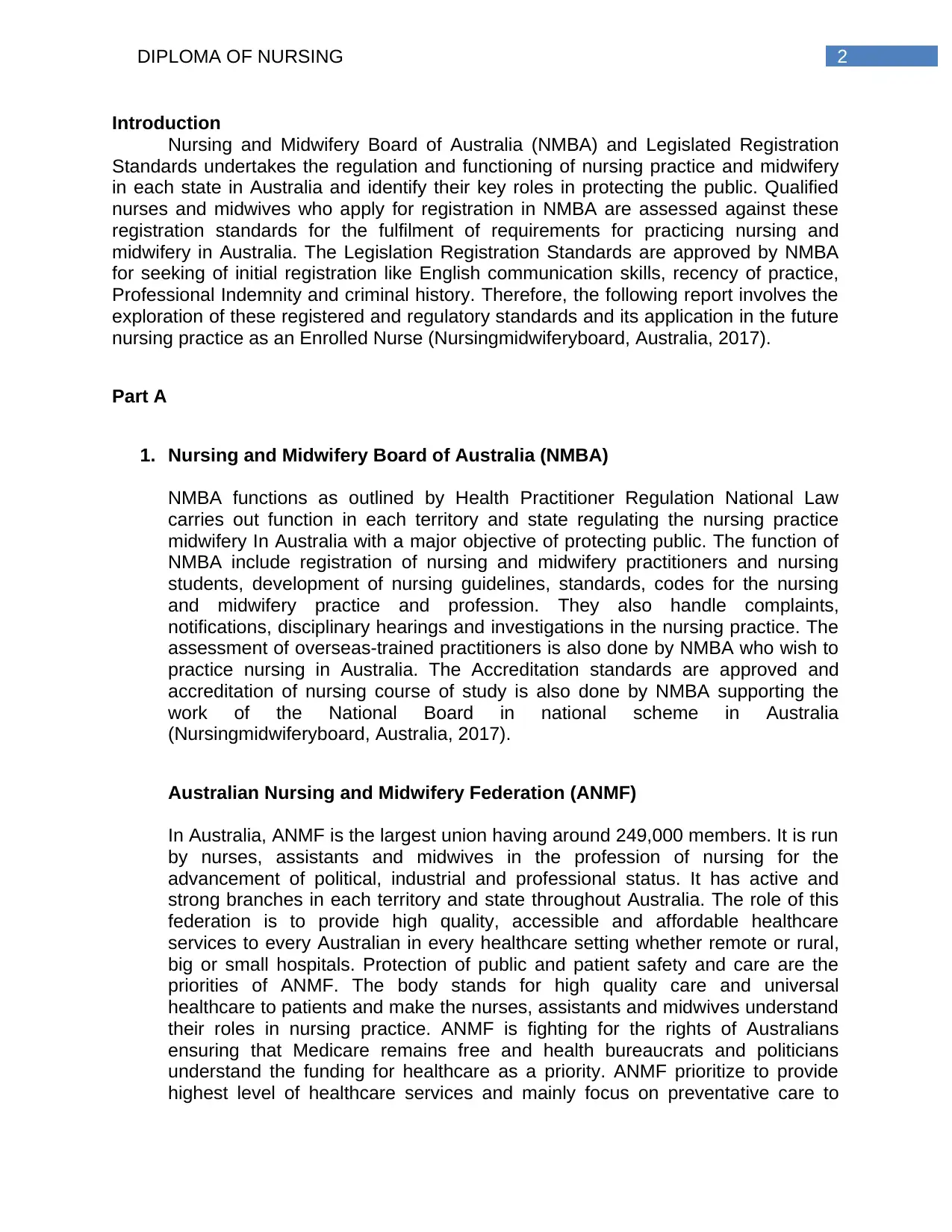
2DIPLOMA OF NURSING
Introduction
Nursing and Midwifery Board of Australia (NMBA) and Legislated Registration
Standards undertakes the regulation and functioning of nursing practice and midwifery
in each state in Australia and identify their key roles in protecting the public. Qualified
nurses and midwives who apply for registration in NMBA are assessed against these
registration standards for the fulfilment of requirements for practicing nursing and
midwifery in Australia. The Legislation Registration Standards are approved by NMBA
for seeking of initial registration like English communication skills, recency of practice,
Professional Indemnity and criminal history. Therefore, the following report involves the
exploration of these registered and regulatory standards and its application in the future
nursing practice as an Enrolled Nurse (Nursingmidwiferyboard, Australia, 2017).
Part A
1. Nursing and Midwifery Board of Australia (NMBA)
NMBA functions as outlined by Health Practitioner Regulation National Law
carries out function in each territory and state regulating the nursing practice
midwifery In Australia with a major objective of protecting public. The function of
NMBA include registration of nursing and midwifery practitioners and nursing
students, development of nursing guidelines, standards, codes for the nursing
and midwifery practice and profession. They also handle complaints,
notifications, disciplinary hearings and investigations in the nursing practice. The
assessment of overseas-trained practitioners is also done by NMBA who wish to
practice nursing in Australia. The Accreditation standards are approved and
accreditation of nursing course of study is also done by NMBA supporting the
work of the National Board in national scheme in Australia
(Nursingmidwiferyboard, Australia, 2017).
Australian Nursing and Midwifery Federation (ANMF)
In Australia, ANMF is the largest union having around 249,000 members. It is run
by nurses, assistants and midwives in the profession of nursing for the
advancement of political, industrial and professional status. It has active and
strong branches in each territory and state throughout Australia. The role of this
federation is to provide high quality, accessible and affordable healthcare
services to every Australian in every healthcare setting whether remote or rural,
big or small hospitals. Protection of public and patient safety and care are the
priorities of ANMF. The body stands for high quality care and universal
healthcare to patients and make the nurses, assistants and midwives understand
their roles in nursing practice. ANMF is fighting for the rights of Australians
ensuring that Medicare remains free and health bureaucrats and politicians
understand the funding for healthcare as a priority. ANMF prioritize to provide
highest level of healthcare services and mainly focus on preventative care to
Introduction
Nursing and Midwifery Board of Australia (NMBA) and Legislated Registration
Standards undertakes the regulation and functioning of nursing practice and midwifery
in each state in Australia and identify their key roles in protecting the public. Qualified
nurses and midwives who apply for registration in NMBA are assessed against these
registration standards for the fulfilment of requirements for practicing nursing and
midwifery in Australia. The Legislation Registration Standards are approved by NMBA
for seeking of initial registration like English communication skills, recency of practice,
Professional Indemnity and criminal history. Therefore, the following report involves the
exploration of these registered and regulatory standards and its application in the future
nursing practice as an Enrolled Nurse (Nursingmidwiferyboard, Australia, 2017).
Part A
1. Nursing and Midwifery Board of Australia (NMBA)
NMBA functions as outlined by Health Practitioner Regulation National Law
carries out function in each territory and state regulating the nursing practice
midwifery In Australia with a major objective of protecting public. The function of
NMBA include registration of nursing and midwifery practitioners and nursing
students, development of nursing guidelines, standards, codes for the nursing
and midwifery practice and profession. They also handle complaints,
notifications, disciplinary hearings and investigations in the nursing practice. The
assessment of overseas-trained practitioners is also done by NMBA who wish to
practice nursing in Australia. The Accreditation standards are approved and
accreditation of nursing course of study is also done by NMBA supporting the
work of the National Board in national scheme in Australia
(Nursingmidwiferyboard, Australia, 2017).
Australian Nursing and Midwifery Federation (ANMF)
In Australia, ANMF is the largest union having around 249,000 members. It is run
by nurses, assistants and midwives in the profession of nursing for the
advancement of political, industrial and professional status. It has active and
strong branches in each territory and state throughout Australia. The role of this
federation is to provide high quality, accessible and affordable healthcare
services to every Australian in every healthcare setting whether remote or rural,
big or small hospitals. Protection of public and patient safety and care are the
priorities of ANMF. The body stands for high quality care and universal
healthcare to patients and make the nurses, assistants and midwives understand
their roles in nursing practice. ANMF is fighting for the rights of Australians
ensuring that Medicare remains free and health bureaucrats and politicians
understand the funding for healthcare as a priority. ANMF prioritize to provide
highest level of healthcare services and mainly focus on preventative care to
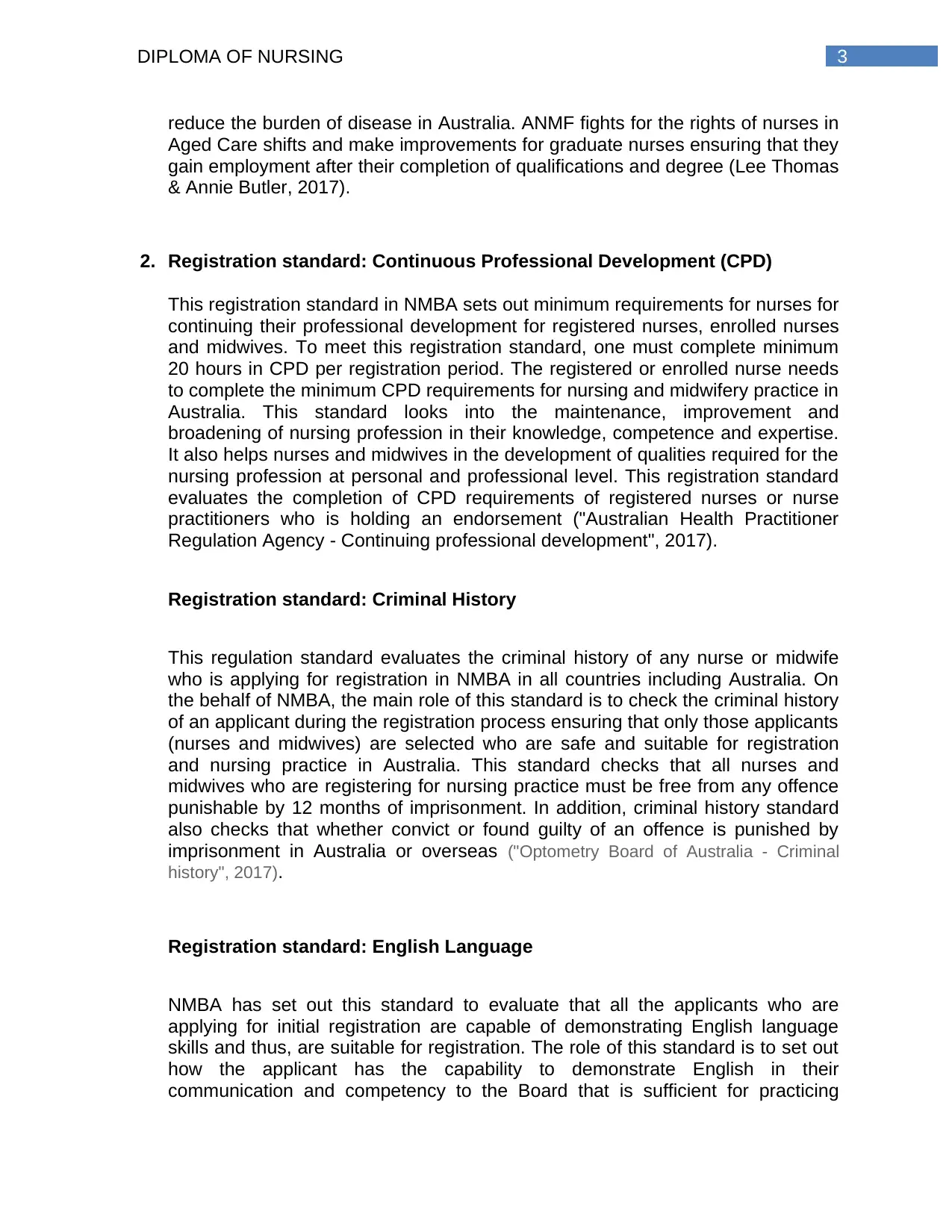
3DIPLOMA OF NURSING
reduce the burden of disease in Australia. ANMF fights for the rights of nurses in
Aged Care shifts and make improvements for graduate nurses ensuring that they
gain employment after their completion of qualifications and degree (Lee Thomas
& Annie Butler, 2017).
2. Registration standard: Continuous Professional Development (CPD)
This registration standard in NMBA sets out minimum requirements for nurses for
continuing their professional development for registered nurses, enrolled nurses
and midwives. To meet this registration standard, one must complete minimum
20 hours in CPD per registration period. The registered or enrolled nurse needs
to complete the minimum CPD requirements for nursing and midwifery practice in
Australia. This standard looks into the maintenance, improvement and
broadening of nursing profession in their knowledge, competence and expertise.
It also helps nurses and midwives in the development of qualities required for the
nursing profession at personal and professional level. This registration standard
evaluates the completion of CPD requirements of registered nurses or nurse
practitioners who is holding an endorsement ("Australian Health Practitioner
Regulation Agency - Continuing professional development", 2017).
Registration standard: Criminal History
This regulation standard evaluates the criminal history of any nurse or midwife
who is applying for registration in NMBA in all countries including Australia. On
the behalf of NMBA, the main role of this standard is to check the criminal history
of an applicant during the registration process ensuring that only those applicants
(nurses and midwives) are selected who are safe and suitable for registration
and nursing practice in Australia. This standard checks that all nurses and
midwives who are registering for nursing practice must be free from any offence
punishable by 12 months of imprisonment. In addition, criminal history standard
also checks that whether convict or found guilty of an offence is punished by
imprisonment in Australia or overseas ("Optometry Board of Australia - Criminal
history", 2017).
Registration standard: English Language
NMBA has set out this standard to evaluate that all the applicants who are
applying for initial registration are capable of demonstrating English language
skills and thus, are suitable for registration. The role of this standard is to set out
how the applicant has the capability to demonstrate English in their
communication and competency to the Board that is sufficient for practicing
reduce the burden of disease in Australia. ANMF fights for the rights of nurses in
Aged Care shifts and make improvements for graduate nurses ensuring that they
gain employment after their completion of qualifications and degree (Lee Thomas
& Annie Butler, 2017).
2. Registration standard: Continuous Professional Development (CPD)
This registration standard in NMBA sets out minimum requirements for nurses for
continuing their professional development for registered nurses, enrolled nurses
and midwives. To meet this registration standard, one must complete minimum
20 hours in CPD per registration period. The registered or enrolled nurse needs
to complete the minimum CPD requirements for nursing and midwifery practice in
Australia. This standard looks into the maintenance, improvement and
broadening of nursing profession in their knowledge, competence and expertise.
It also helps nurses and midwives in the development of qualities required for the
nursing profession at personal and professional level. This registration standard
evaluates the completion of CPD requirements of registered nurses or nurse
practitioners who is holding an endorsement ("Australian Health Practitioner
Regulation Agency - Continuing professional development", 2017).
Registration standard: Criminal History
This regulation standard evaluates the criminal history of any nurse or midwife
who is applying for registration in NMBA in all countries including Australia. On
the behalf of NMBA, the main role of this standard is to check the criminal history
of an applicant during the registration process ensuring that only those applicants
(nurses and midwives) are selected who are safe and suitable for registration
and nursing practice in Australia. This standard checks that all nurses and
midwives who are registering for nursing practice must be free from any offence
punishable by 12 months of imprisonment. In addition, criminal history standard
also checks that whether convict or found guilty of an offence is punished by
imprisonment in Australia or overseas ("Optometry Board of Australia - Criminal
history", 2017).
Registration standard: English Language
NMBA has set out this standard to evaluate that all the applicants who are
applying for initial registration are capable of demonstrating English language
skills and thus, are suitable for registration. The role of this standard is to set out
how the applicant has the capability to demonstrate English in their
communication and competency to the Board that is sufficient for practicing
Secure Best Marks with AI Grader
Need help grading? Try our AI Grader for instant feedback on your assignments.

4DIPLOMA OF NURSING
nursing or midwifery. Two English language skills are registered in the standard
that comprises of common English language applicable during initial registration
and NM English language skills applicable for all nurses and midwives ("Nursing
and Midwifery Board of Australia - English language skills", 2017).
Registration standard: Professional Indemnity
Australian Health Workforce Ministerial Council approves this registration
standard stating that no nurses and midwives who have not covered appropriate
professional indemnity insurance (PII) arrangements are allowed to practice in
their respective profession. The board has approved appropriate PII guidelines in
conjunction with NMBA standards. The standard checks that whether registered
health practitioners hold PII arrangements that is important part of National
Scheme in protecting public and addressing of risk posed by practitioners who
are uninsured. PII covers civil liability, unlimited retroactive and runoff in different
types of nursing practice. Nurses and midwives who are holding insurance
coverage in their own name are required to retain and show documentary
evidence of PII or any insurance arrangements to the Board ("Nursing and
Midwifery Board of Australia - English language skills", 2017)..
Registration standard: Recency of Practice
This standard means that a nurse or midwife should maintain adequate
connection with the recent practice in their profession for which they are
obtaining registration. The standard evaluates that the applicant is carrying valid
and current nursing or midwifery registration either in Australia or overseas. It
also sets out the role of nurses or midwives applying for registration whether they
possess appropriate skills and qualifications relevant in their area of practice in
nursing ("Australian Health Practitioner Regulation Agency - Recency of
practice", 2017).
Enrolled Nurse Standards for Practice
This standard includes core practice guidelines providing a framework for the
nurses for the assessment of enrolled nurse (EN) practice. NMBA sets out three
domains under this standard that demonstrates that EN should work in
collaboration with registered nurses, work towards provision of care and reflect
analytical practice. This standard assesses the knowledge, capabilities, attitudes
and skills of enrolled nurses within the clinically focused domains ("Australian
Health Practitioner Regulation Agency - Recency of practice", 2017).
nursing or midwifery. Two English language skills are registered in the standard
that comprises of common English language applicable during initial registration
and NM English language skills applicable for all nurses and midwives ("Nursing
and Midwifery Board of Australia - English language skills", 2017).
Registration standard: Professional Indemnity
Australian Health Workforce Ministerial Council approves this registration
standard stating that no nurses and midwives who have not covered appropriate
professional indemnity insurance (PII) arrangements are allowed to practice in
their respective profession. The board has approved appropriate PII guidelines in
conjunction with NMBA standards. The standard checks that whether registered
health practitioners hold PII arrangements that is important part of National
Scheme in protecting public and addressing of risk posed by practitioners who
are uninsured. PII covers civil liability, unlimited retroactive and runoff in different
types of nursing practice. Nurses and midwives who are holding insurance
coverage in their own name are required to retain and show documentary
evidence of PII or any insurance arrangements to the Board ("Nursing and
Midwifery Board of Australia - English language skills", 2017)..
Registration standard: Recency of Practice
This standard means that a nurse or midwife should maintain adequate
connection with the recent practice in their profession for which they are
obtaining registration. The standard evaluates that the applicant is carrying valid
and current nursing or midwifery registration either in Australia or overseas. It
also sets out the role of nurses or midwives applying for registration whether they
possess appropriate skills and qualifications relevant in their area of practice in
nursing ("Australian Health Practitioner Regulation Agency - Recency of
practice", 2017).
Enrolled Nurse Standards for Practice
This standard includes core practice guidelines providing a framework for the
nurses for the assessment of enrolled nurse (EN) practice. NMBA sets out three
domains under this standard that demonstrates that EN should work in
collaboration with registered nurses, work towards provision of care and reflect
analytical practice. This standard assesses the knowledge, capabilities, attitudes
and skills of enrolled nurses within the clinically focused domains ("Australian
Health Practitioner Regulation Agency - Recency of practice", 2017).
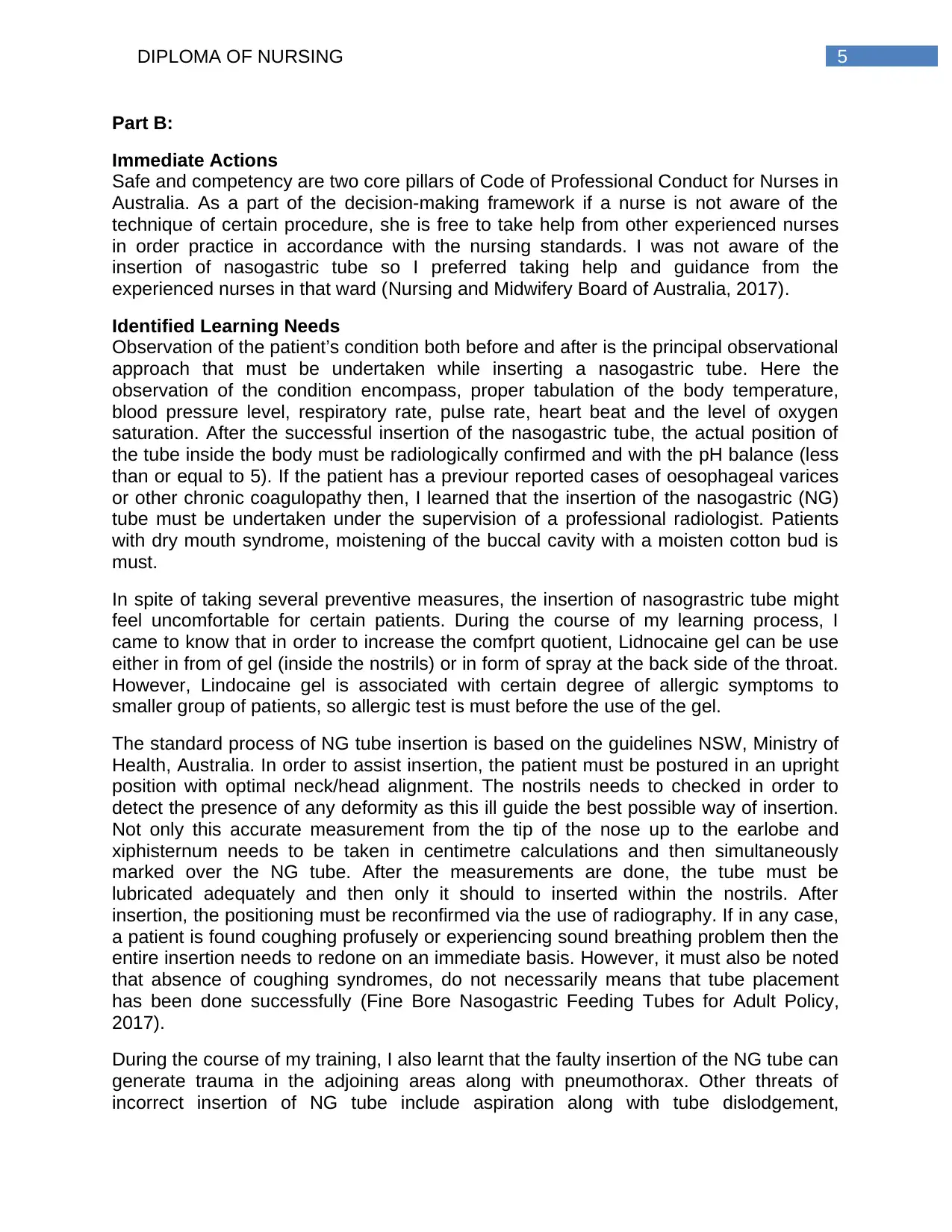
5DIPLOMA OF NURSING
Part B:
Immediate Actions
Safe and competency are two core pillars of Code of Professional Conduct for Nurses in
Australia. As a part of the decision-making framework if a nurse is not aware of the
technique of certain procedure, she is free to take help from other experienced nurses
in order practice in accordance with the nursing standards. I was not aware of the
insertion of nasogastric tube so I preferred taking help and guidance from the
experienced nurses in that ward (Nursing and Midwifery Board of Australia, 2017).
Identified Learning Needs
Observation of the patient’s condition both before and after is the principal observational
approach that must be undertaken while inserting a nasogastric tube. Here the
observation of the condition encompass, proper tabulation of the body temperature,
blood pressure level, respiratory rate, pulse rate, heart beat and the level of oxygen
saturation. After the successful insertion of the nasogastric tube, the actual position of
the tube inside the body must be radiologically confirmed and with the pH balance (less
than or equal to 5). If the patient has a previour reported cases of oesophageal varices
or other chronic coagulopathy then, I learned that the insertion of the nasogastric (NG)
tube must be undertaken under the supervision of a professional radiologist. Patients
with dry mouth syndrome, moistening of the buccal cavity with a moisten cotton bud is
must.
In spite of taking several preventive measures, the insertion of nasograstric tube might
feel uncomfortable for certain patients. During the course of my learning process, I
came to know that in order to increase the comfprt quotient, Lidnocaine gel can be use
either in from of gel (inside the nostrils) or in form of spray at the back side of the throat.
However, Lindocaine gel is associated with certain degree of allergic symptoms to
smaller group of patients, so allergic test is must before the use of the gel.
The standard process of NG tube insertion is based on the guidelines NSW, Ministry of
Health, Australia. In order to assist insertion, the patient must be postured in an upright
position with optimal neck/head alignment. The nostrils needs to checked in order to
detect the presence of any deformity as this ill guide the best possible way of insertion.
Not only this accurate measurement from the tip of the nose up to the earlobe and
xiphisternum needs to be taken in centimetre calculations and then simultaneously
marked over the NG tube. After the measurements are done, the tube must be
lubricated adequately and then only it should to inserted within the nostrils. After
insertion, the positioning must be reconfirmed via the use of radiography. If in any case,
a patient is found coughing profusely or experiencing sound breathing problem then the
entire insertion needs to redone on an immediate basis. However, it must also be noted
that absence of coughing syndromes, do not necessarily means that tube placement
has been done successfully (Fine Bore Nasogastric Feeding Tubes for Adult Policy,
2017).
During the course of my training, I also learnt that the faulty insertion of the NG tube can
generate trauma in the adjoining areas along with pneumothorax. Other threats of
incorrect insertion of NG tube include aspiration along with tube dislodgement,
Part B:
Immediate Actions
Safe and competency are two core pillars of Code of Professional Conduct for Nurses in
Australia. As a part of the decision-making framework if a nurse is not aware of the
technique of certain procedure, she is free to take help from other experienced nurses
in order practice in accordance with the nursing standards. I was not aware of the
insertion of nasogastric tube so I preferred taking help and guidance from the
experienced nurses in that ward (Nursing and Midwifery Board of Australia, 2017).
Identified Learning Needs
Observation of the patient’s condition both before and after is the principal observational
approach that must be undertaken while inserting a nasogastric tube. Here the
observation of the condition encompass, proper tabulation of the body temperature,
blood pressure level, respiratory rate, pulse rate, heart beat and the level of oxygen
saturation. After the successful insertion of the nasogastric tube, the actual position of
the tube inside the body must be radiologically confirmed and with the pH balance (less
than or equal to 5). If the patient has a previour reported cases of oesophageal varices
or other chronic coagulopathy then, I learned that the insertion of the nasogastric (NG)
tube must be undertaken under the supervision of a professional radiologist. Patients
with dry mouth syndrome, moistening of the buccal cavity with a moisten cotton bud is
must.
In spite of taking several preventive measures, the insertion of nasograstric tube might
feel uncomfortable for certain patients. During the course of my learning process, I
came to know that in order to increase the comfprt quotient, Lidnocaine gel can be use
either in from of gel (inside the nostrils) or in form of spray at the back side of the throat.
However, Lindocaine gel is associated with certain degree of allergic symptoms to
smaller group of patients, so allergic test is must before the use of the gel.
The standard process of NG tube insertion is based on the guidelines NSW, Ministry of
Health, Australia. In order to assist insertion, the patient must be postured in an upright
position with optimal neck/head alignment. The nostrils needs to checked in order to
detect the presence of any deformity as this ill guide the best possible way of insertion.
Not only this accurate measurement from the tip of the nose up to the earlobe and
xiphisternum needs to be taken in centimetre calculations and then simultaneously
marked over the NG tube. After the measurements are done, the tube must be
lubricated adequately and then only it should to inserted within the nostrils. After
insertion, the positioning must be reconfirmed via the use of radiography. If in any case,
a patient is found coughing profusely or experiencing sound breathing problem then the
entire insertion needs to redone on an immediate basis. However, it must also be noted
that absence of coughing syndromes, do not necessarily means that tube placement
has been done successfully (Fine Bore Nasogastric Feeding Tubes for Adult Policy,
2017).
During the course of my training, I also learnt that the faulty insertion of the NG tube can
generate trauma in the adjoining areas along with pneumothorax. Other threats of
incorrect insertion of NG tube include aspiration along with tube dislodgement,
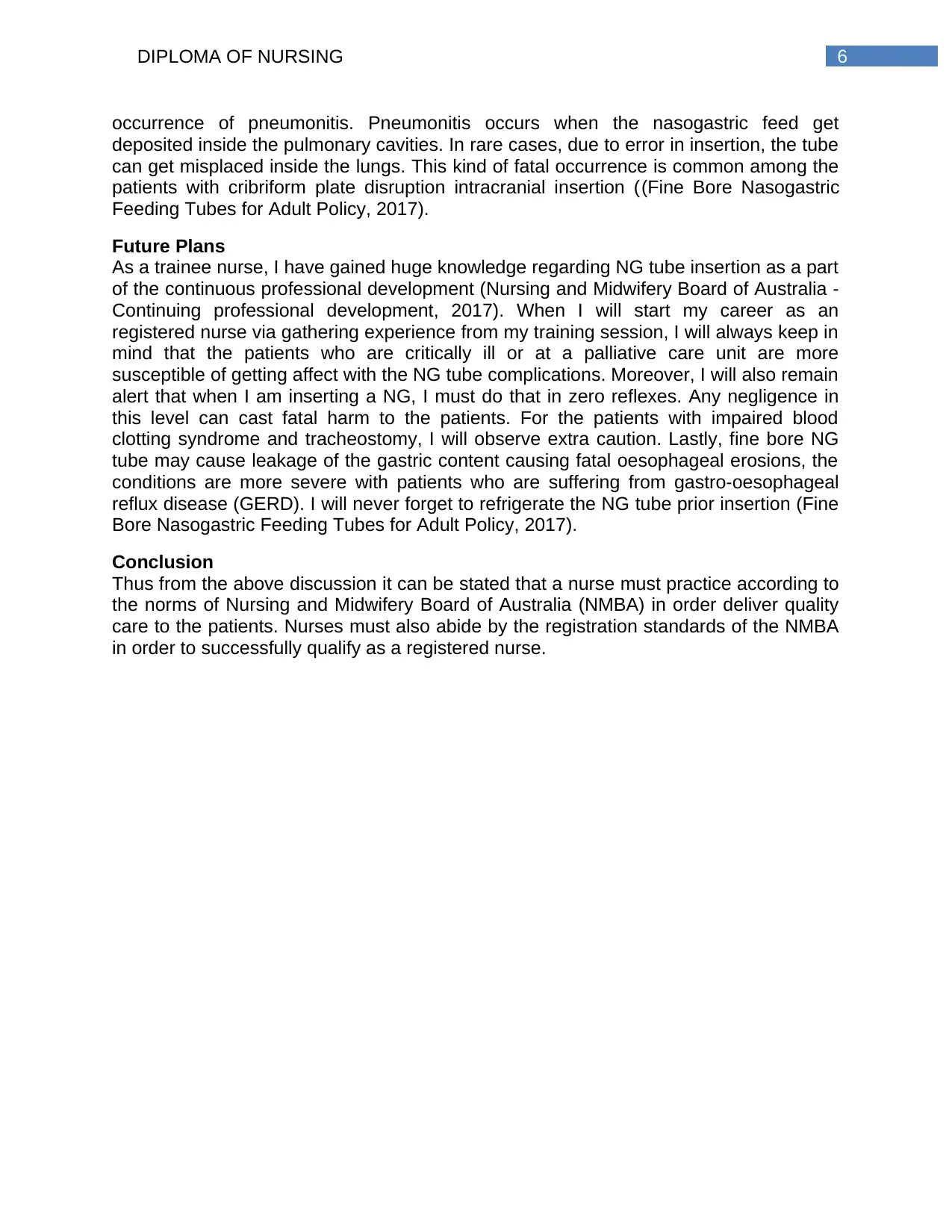
6DIPLOMA OF NURSING
occurrence of pneumonitis. Pneumonitis occurs when the nasogastric feed get
deposited inside the pulmonary cavities. In rare cases, due to error in insertion, the tube
can get misplaced inside the lungs. This kind of fatal occurrence is common among the
patients with cribriform plate disruption intracranial insertion ((Fine Bore Nasogastric
Feeding Tubes for Adult Policy, 2017).
Future Plans
As a trainee nurse, I have gained huge knowledge regarding NG tube insertion as a part
of the continuous professional development (Nursing and Midwifery Board of Australia -
Continuing professional development, 2017). When I will start my career as an
registered nurse via gathering experience from my training session, I will always keep in
mind that the patients who are critically ill or at a palliative care unit are more
susceptible of getting affect with the NG tube complications. Moreover, I will also remain
alert that when I am inserting a NG, I must do that in zero reflexes. Any negligence in
this level can cast fatal harm to the patients. For the patients with impaired blood
clotting syndrome and tracheostomy, I will observe extra caution. Lastly, fine bore NG
tube may cause leakage of the gastric content causing fatal oesophageal erosions, the
conditions are more severe with patients who are suffering from gastro-oesophageal
reflux disease (GERD). I will never forget to refrigerate the NG tube prior insertion (Fine
Bore Nasogastric Feeding Tubes for Adult Policy, 2017).
Conclusion
Thus from the above discussion it can be stated that a nurse must practice according to
the norms of Nursing and Midwifery Board of Australia (NMBA) in order deliver quality
care to the patients. Nurses must also abide by the registration standards of the NMBA
in order to successfully qualify as a registered nurse.
occurrence of pneumonitis. Pneumonitis occurs when the nasogastric feed get
deposited inside the pulmonary cavities. In rare cases, due to error in insertion, the tube
can get misplaced inside the lungs. This kind of fatal occurrence is common among the
patients with cribriform plate disruption intracranial insertion ((Fine Bore Nasogastric
Feeding Tubes for Adult Policy, 2017).
Future Plans
As a trainee nurse, I have gained huge knowledge regarding NG tube insertion as a part
of the continuous professional development (Nursing and Midwifery Board of Australia -
Continuing professional development, 2017). When I will start my career as an
registered nurse via gathering experience from my training session, I will always keep in
mind that the patients who are critically ill or at a palliative care unit are more
susceptible of getting affect with the NG tube complications. Moreover, I will also remain
alert that when I am inserting a NG, I must do that in zero reflexes. Any negligence in
this level can cast fatal harm to the patients. For the patients with impaired blood
clotting syndrome and tracheostomy, I will observe extra caution. Lastly, fine bore NG
tube may cause leakage of the gastric content causing fatal oesophageal erosions, the
conditions are more severe with patients who are suffering from gastro-oesophageal
reflux disease (GERD). I will never forget to refrigerate the NG tube prior insertion (Fine
Bore Nasogastric Feeding Tubes for Adult Policy, 2017).
Conclusion
Thus from the above discussion it can be stated that a nurse must practice according to
the norms of Nursing and Midwifery Board of Australia (NMBA) in order deliver quality
care to the patients. Nurses must also abide by the registration standards of the NMBA
in order to successfully qualify as a registered nurse.
Paraphrase This Document
Need a fresh take? Get an instant paraphrase of this document with our AI Paraphraser

7DIPLOMA OF NURSING
References
Australian Health Practitioner Regulation Agency - Continuing professional
development. (2017). Ahpra.gov.au. Retrieved 8 November 2017, from
https://www.ahpra.gov.au/Registration/Registration-Standards/CPD.aspx
Australian Health Practitioner Regulation Agency - Recency of practice.
(2017). Ahpra.gov.au. Retrieved 8 November 2017, from
https://www.ahpra.gov.au/Registration/Registration-Standards/Recency-of-
practice.aspx
Fine Bore Nasogastric Feeding Tubes for Adult Policy. (2017) (pp. 1 to 8). Australia.
Retrieved from http://www1.health.nsw.gov.au/pds/ActivePDSDocuments
Lee Thomas, A., & Annie Butler, A. (2017). Australian Nursing & Midwifery
Federation. Anmf.org.au. Retrieved 8 November 2017, from http://anmf.org.au/
Nursing and Midwifery Board of Australia - Continuing professional development.
(2017). Nursingmidwiferyboard.gov.au. Retrieved 8 November 2017, from
http://www.nursingmidwiferyboard.gov.au/Registration-Standards/Continuing-
professional-development.aspx
Nursing and Midwifery Board of Australia - English language skills.
(2017). Nursingmidwiferyboard.gov.au. Retrieved 8 November 2017, from
http://www.nursingmidwiferyboard.gov.au/Registration-Standards/English-
language-skills.aspx
Nursing and Midwifery Board of Australia - Home. (2017).
Nursingmidwiferyboard.gov.au. Retrieved 8 November 2017, from
http://www.nursingmidwiferyboard.gov.au/
Nursingmidwiferyboard, Australia. (2017). Nursing and Midwifery Board of Australia -
Home. Nursingmidwiferyboard.gov.au. Retrieved 8 November 2017, from
http://www.nursingmidwiferyboard.gov.au/
Optometry Board of Australia - Criminal history. (2017). Optometryboard.gov.au.
Retrieved 8 November 2017, from
http://www.optometryboard.gov.au/Registration-Standards/Criminal-history.aspx
References
Australian Health Practitioner Regulation Agency - Continuing professional
development. (2017). Ahpra.gov.au. Retrieved 8 November 2017, from
https://www.ahpra.gov.au/Registration/Registration-Standards/CPD.aspx
Australian Health Practitioner Regulation Agency - Recency of practice.
(2017). Ahpra.gov.au. Retrieved 8 November 2017, from
https://www.ahpra.gov.au/Registration/Registration-Standards/Recency-of-
practice.aspx
Fine Bore Nasogastric Feeding Tubes for Adult Policy. (2017) (pp. 1 to 8). Australia.
Retrieved from http://www1.health.nsw.gov.au/pds/ActivePDSDocuments
Lee Thomas, A., & Annie Butler, A. (2017). Australian Nursing & Midwifery
Federation. Anmf.org.au. Retrieved 8 November 2017, from http://anmf.org.au/
Nursing and Midwifery Board of Australia - Continuing professional development.
(2017). Nursingmidwiferyboard.gov.au. Retrieved 8 November 2017, from
http://www.nursingmidwiferyboard.gov.au/Registration-Standards/Continuing-
professional-development.aspx
Nursing and Midwifery Board of Australia - English language skills.
(2017). Nursingmidwiferyboard.gov.au. Retrieved 8 November 2017, from
http://www.nursingmidwiferyboard.gov.au/Registration-Standards/English-
language-skills.aspx
Nursing and Midwifery Board of Australia - Home. (2017).
Nursingmidwiferyboard.gov.au. Retrieved 8 November 2017, from
http://www.nursingmidwiferyboard.gov.au/
Nursingmidwiferyboard, Australia. (2017). Nursing and Midwifery Board of Australia -
Home. Nursingmidwiferyboard.gov.au. Retrieved 8 November 2017, from
http://www.nursingmidwiferyboard.gov.au/
Optometry Board of Australia - Criminal history. (2017). Optometryboard.gov.au.
Retrieved 8 November 2017, from
http://www.optometryboard.gov.au/Registration-Standards/Criminal-history.aspx
1 out of 8
Related Documents
Your All-in-One AI-Powered Toolkit for Academic Success.
+13062052269
info@desklib.com
Available 24*7 on WhatsApp / Email
![[object Object]](/_next/static/media/star-bottom.7253800d.svg)
Unlock your academic potential
© 2024 | Zucol Services PVT LTD | All rights reserved.





